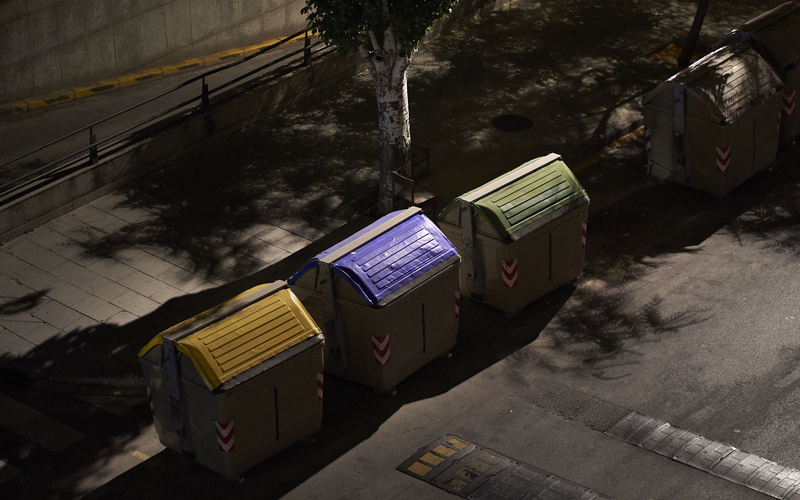
Photo: Ignasi Ruiz | Dreamstime.com
The secret life of waste bins
09 August 2021
by Sarah Wray
Like streetlights, trash cans are emerging as an important form of digital infrastructure for cities, helping them collect much more than just rubbish.
During the pandemic, Dublin used its smart, solar-powered bins to collate data on footfall and understand how busy areas are.
On a recent Cities Today digital roundtable, one US CIO shared how a smart bin pilot drove ideas for new facilities for homeless people. Trash can sensors were showing bins as suddenly full and then emptier again, even though no one had attended to them. Staff were perplexed. It turned out that homeless residents were storing their belongings in the bins when it rained, then taking them out and replacing the rubbish.
“It’s interesting because you collect these pieces of data that you don’t expect,” commented the CIO.
Swiss technology company Paradox Engineering is working on a new smart waste solution featuring machine learning capabilities.
Julia Arneri Borghese, Chief Marketing Officer at Paradox Engineering, said: “The idea is to have the bin telling you, over a whole map of your city, which bins are empty and which are full. Over time, thanks to artificial intelligence, the system will predict which one is going to be full and when, and plan the optimal routes for you.”
Avoiding overflowing bins is not the only benefit – cities can reduce truck rolls and use smaller, cleaner waste vehicles to cut emissions and congestion.
“That’s a major benefit in the US, and in Europe where there are older cities that don’t allow for big trucks but have a lot of full bins because of the high density of inhabitants and tourists,” Arneri Borghese said.
Amsterdam, for instance, is exploring alternatives such as electric waste boats and e-cargo bikes, alongside its underground waste system.
Paradox Engineering is also interested in developing the idea of enabling cities to use blockchain-based tokens to reward citizens for disposing of rubbish correctly.
Arneri Borghese explained: “This helps recycling targets and citizens can spend the tokens with local businesses. In turn that’s good for the local economy and it generates tax revenue. It’s a virtuous circle that is enabled by technology at the base.”
‘Holy grail’
In San Leandro, a large suburban town on the eastern shore of San Francisco Bay in California, a smart trash pilot programme also showed the importance of enabling technology, emerging out of a smart lighting project.
In 2016, the city council selected Climatec, an energy services company, in a US$5.2 million deal to install energy and water-saving equipment. The agreement included a guarantee that savings would cover 100 percent of the costs of the improvements and related debt services. Paradox Engineering was brought on as a partner.
Around 5,000 streetlights were replaced with smart LED lamps, using the city’s existing fibre optic network and Paradox Engineering’s PE Smart Urban Network as the centralised management and control system.
Climatec calculated that the entire investment will generate US$8 million in savings over 15 years through reductions in energy and water use, and US$1.5 million in positive cash flow over that time. In addition to the financial benefits, the infrastructure is projected to reduce greenhouse gas emissions by 1,390 metric tons annually. A 2019 National Institute of Standards and Technology (NIST) report revealed that San Leandro is saving US$447,000 a year and seeing energy reductions which are the equivalent of removing over 2,000 metric tons of CO2 annually from the environment.
San Leandro leaders also saw that the network offered new possibilities that they hadn’t foreseen.
Deborah Acosta, former Chief Innovation Officer, City of San Leandro and CEO and Founder of WeAccel, said: “It took us a little bit of time before we realised: ‘Wait a minute, this isn’t just a lighting project. This is our holy grail, this is the IoT mesh network that we’ve been hearing about. This is the dashboard that all of our data can be connected to and visualised through.”
Spurred by this, the city teamed up with Pilot City in 2017 to work with students from Harvey Mudd College on a smart waste monitoring pilot solution, using street trash cans connected to the PE Smart Urban Network.
“It was not just about the platform itself; it’s about the impact on our younger people who were excited to engage in solving a city-wide problem through technology,” said Acosta. “Suddenly, San Leandro wasn’t this dowdy old town where nothing was ever happening and they were going to have to leave in order to make any life for themselves. Suddenly, they could see themselves coming back to the city and helping it through its transformation.”
Arneri Borghese says an interoperable approach is the key.
“Cities always tell us: ‘It’s hard for us to predict what our next challenge will be, but we need to be ready for that’. A network which allows all the applications that are needed to be supported opens up a whole world of new things to be added over time.”
Image: | Dreamstime.com









